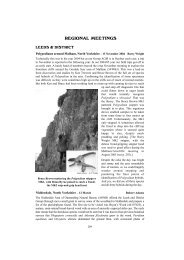Full Contents as pdf File - Natural History Museum
Full Contents as pdf File - Natural History Museum
Full Contents as pdf File - Natural History Museum
Create successful ePaper yourself
Turn your PDF publications into a flip-book with our unique Google optimized e-Paper software.
(A. distentifolium). Fred bemoaned the fact that project funding w<strong>as</strong> difficult to obtain,<br />
unless the proposed study w<strong>as</strong> on a ‘good’ species (so in a sense it w<strong>as</strong> unfortunate that<br />
‘A. flexile’ w<strong>as</strong> no longer that!). As a corollary to this example, the morphological concept<br />
w<strong>as</strong> also weakened where two or more entities looked very similar, but were in fact<br />
different ‘cryptic’ species, examples being given in the genera Polypodium in Britain, and<br />
Botrychium in North America. Because there are relatively few fern species in Britain, and<br />
because spores can travel great distances, we have no narrow endemics here.<br />
Speciation can occur in several ways. Primary speciation occurs where lineages diverge<br />
through isolation, either geographical or ecological. An example of the former process in<br />
action w<strong>as</strong> given. The ferns Dryopteris azorica (Azores), D. maderensis (Madeira) and<br />
D. intermedia (North America) are closely related, to the extent that the first two are considered<br />
by some to be subspecies of D. intermedia. Another difficulty occurs in the Diph<strong>as</strong>i<strong>as</strong>trum<br />
complex, where apparently well defined species interbreed to produce fertile offspring,<br />
suggesting that only a single species may in fact be involved. Here the ecological separation<br />
that h<strong>as</strong> allowed these taxa to diverge breaks down in certain situations. Fern speciation is,<br />
however, more often the result of a more rapid process of change and reproductive isolation,<br />
that which includes polyploidy alone (autopolyploids), or in combination with hybridisation<br />
(allopolyploidy). New species formed in this way may be morphologically very similar to their<br />
descendants, posing difficulties for identification. Fred showed slides of the two well known<br />
Guernsey endemic hybrids Asplenium x microdon (A. scolopendrium x A. obovatum subsp.<br />
lanceolatum) and A. x sarniense (A. adiantum-nigrum x A. obovatum subsp. lanceolatum) to<br />
demonstrate the clear morphological difference from the parents in the former, and the close<br />
morphological similarity with the parents in the latter. This secondary speciation is occurring<br />
in most fern groups, including the most taxonomically difficult such <strong>as</strong> the Asplenium<br />
trichomanes complex. Although these entities look morphologically similar, their populations<br />
are divergent and they cannot interbreed, therefore they must be considered <strong>as</strong> distinct<br />
species. Fred gave us an excellent flavour of the issues involved in answering the question<br />
posed in the title of his talk, but stopped short of providing the definitive answer!<br />
The lunch break provided the opportunity for members to peruse the books and<br />
merchandise tables, where Bryan Smith displayed some tempting new BPS ranges of<br />
clothing, cards and mugs. Then followed the AGM, which is minuted elsewhere.<br />
Following the AGM, Jennifer Ide showed a few slides of the fern dell at Brodsworth Hall in<br />
Yorkshire. This is where the fern collection of the late Eric Baker now resides, and<br />
Jennifer’s shots well illustrated the layout of this attractive garden feature.<br />
Members then had the choice of indulging in ‘fern chat’, or accompanying Alison to the<br />
herbarium. The first part of this visit w<strong>as</strong> to see Sir Hans Sloane’s Herbarium, the founding<br />
<strong>Museum</strong> collection. Here we inspected an example of Phlebodium aureum, one of the<br />
species Josephine had used to illustrate her talk. It w<strong>as</strong> awe-inspiring to realise that this<br />
specimen w<strong>as</strong> over 300 years old. This herbarium is set <strong>as</strong>ide in its own room with a<br />
controlled environment. The herbarium sheets are bound into volumes and housed<br />
horizontally in attractive wooden cabinets. The collection also includes other Sloane<br />
artefacts, such <strong>as</strong> the ‘vegetable lamb of Tartary’ (the rhizome of Cibotium barometz). We<br />
then moved to the Cryptogamic Herbarium, where Alison had on display fern herbarium<br />
sheets, many of which had been used to illustrate her talk. She gave an informal account of<br />
various <strong>as</strong>pects of the herbarium, including the work required when genera are revised, how<br />
one learns to interpret abbreviations, the herbarium index and the spirit collection.<br />
So ended a highly enjoyable day, ‘engineered’ by Alison, Fred and Josephine. As well <strong>as</strong><br />
preparing and presenting their respective talks so wonderfully, they also performed all the<br />
groundwork and logistics to provide such a well run and memorable day. Thank you all!<br />
117

















